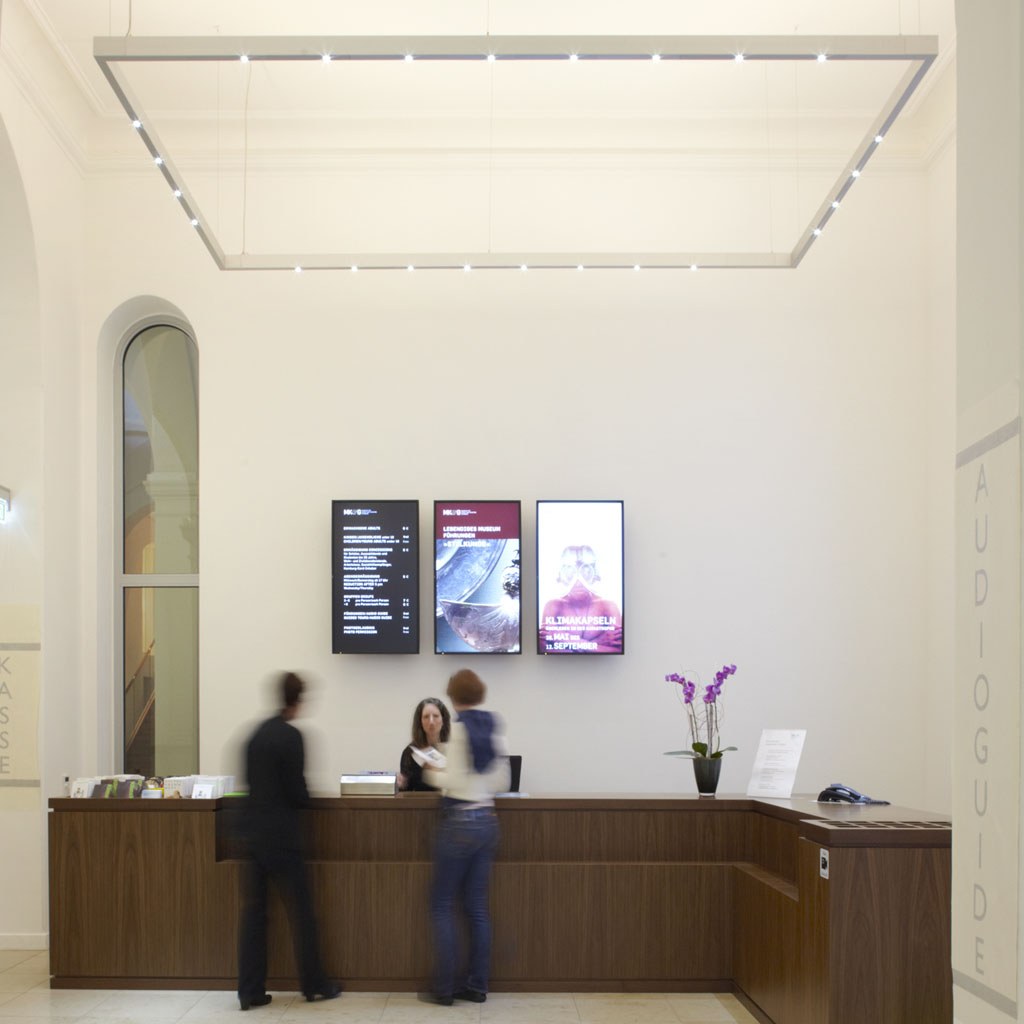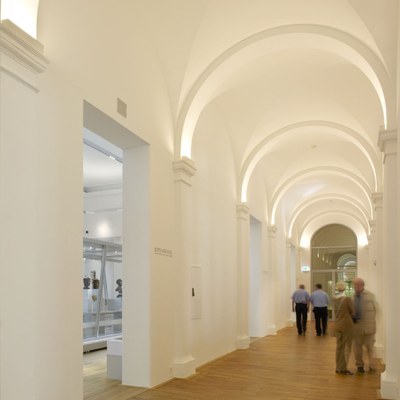New Lighting Solution for Hamburg’s Museum of Art and Industry
At the refurbished Museum of Art and Industry, the multifunctional Supersystem LED lighting system works at its best: paintings and sculptures are highlighted in all their facets by its attractive, brilliant light.
The Museum für Kunst und Gewerbe in Hamburg now welcomes its guests in an entrance hall flooded with light. New visual axes across the building provide improved orientation for visitors and allow lots of daylight to enter the historic building. The contemporary interior design is enhanced by a state-of-the-art lighting solution incorporating Zumtobel’s Supersystem LED lighting system. As the museum’s technical director, Thomas Frey, points out: “From the very beginning we tended towards an LED solution, and now we have achieved a highly attractive result thanks to the professional technical support provided by Zumtobel.”
“More light” was the approach favoured by the Hamburg-based architectural studio of MRJ-Architekten, which was commissioned with the redesign of the entrance areas, among other things. In collaboration with interior designer Renate Müller, refurbishment of the museum was carried out in several construction phases. While former storage areas were turned into modern administrative offices, a new annex was added in the inner courtyard to accommodate the museum management. A special highlight is the new main entrance, which together with the adjacent foyer has been redesigned to form a brightly lit, visitor-friendly entrance area including a book store and a display area for special exhibitions.
With an average of 250,000 visitors per year, the Museum of Art and Industry, which is over 130 years old, is one of the leading museums of its kind in Europe. The aim of refurbishing and renovating the main entrance was to create a spacious reception, waiting and ticket office area, to welcome the increasing flow of visitors in an appropriate way and to facilitate orientation. The redesign project, with total costs amounting to € 9 million, was financed by several foundations and sponsors, among them the Hermann Reemtsma foundation and the main sponsor Harald Hartog.
The historic stucco ceilings were completely exposed and restored, the plasterboard walls that had been raised were removed, and connecting doors were shifted to the side wings. On the basis of the remaining masonry, the pilasters with their bases and capitals that had formerly been integrated into the walls could be reconstructed in their entirety, so that now they act not only as an embellishment of the entrance area in their original beauty, but also as load-bearing structures of the cross vault again. A pleasant atmosphere is created by discreetly built-in special luminaires providing indirect illumination of the ceiling. In the east-west direction, the view is now clear through to the opposite western entrance, where walls were removed and replaced by a glass door, analogous to the main entrance. Thus, the building’s central axis is now lit by sunlight, both in the morning and in the evening. The view into the exhibition areas from outside through the glass doors stirs up curiosity, providing a visual link between the various areas.
It was the museum’s director, Prof. Sabine Schulze, who suggested the use of Zumtobel’s LED Supersystem in order to present the works of art displayed in the exhibition areas in the right light. The visually unobtrusive system incorporating a delicate aluminium section impressed Ms. Schulze when she set eyes on it at the Städel Museum in Frankfurt, where it had been installed for the very first time. With the multi-functional LED Supersystem, power consumption is reduced to a minimum. Only 2.5 W are required by the light-emitting diodes that are arranged in groups of three on the underside of the pendant luminaires. Directed downwards, they provide pleasant ambient lighting in the lounges and exhibition areas. In order to allow illumination of the artworks in a targeted manner from various directions, they can be pulled out individually and aligned towards an object. Their light is UV- and IR-free, so as not to cause any damage to the highly sensitive paintings and sculptures. The indirect component comes from fluorescent lamps, which can be adjusted in brightness. To fit into the exhibition showcases, the Supersystem was modified and can now be integrated unobtrusively, yet efficiently into the frame.
A variety of lighting scenes have already been pre-programmed and can be selected using the switch panel. Thus, the exhibits, decoration and lighting system can be matched perfectly, so that visitors will be faced with a well-balanced overall experience.
Project Information: Museum für Kunst und Gewerbe (Museum of Art and Industry), Hamburg/D
Client:
City of Hamburg, Hamburg/D
Architect:
Masterplan: MKG Architekten, Hamburg/D
Museum refurbishment: MRJ Architekten, Hamburg/D
Lighting design:
Masterplan: Peter Andres Lichtplanung, Hamburg/D
Lighting solutions:
Supersystem in suspended version with 3 LED Superspots of 2.5 W each and adjustable indirect lighting special luminaires for corridors and circulation areas





